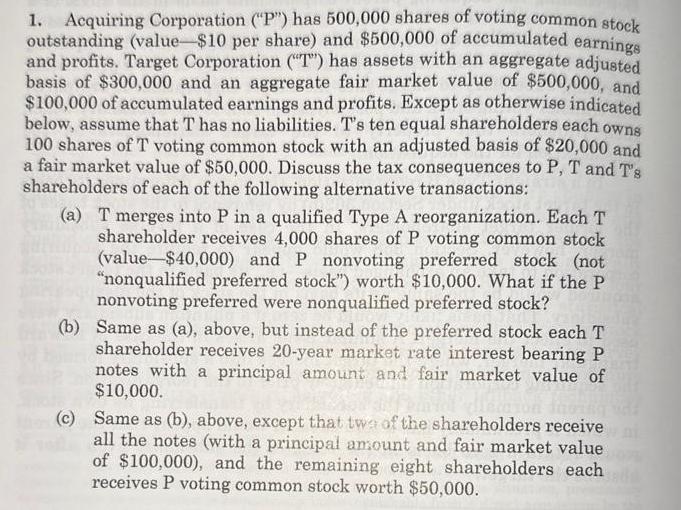Answered step by step
Verified Expert Solution
Question
1 Approved Answer
1. Acquiring Corporation (P) has 500,000 shares of voting common stock outstanding (value $10 per share) and $500,000 of accumulated earnings and profits. Target


1. Acquiring Corporation ("P") has 500,000 shares of voting common stock outstanding (value $10 per share) and $500,000 of accumulated earnings and profits. Target Corporation ("T") has assets with an aggregate adjusted basis of $300,000 and an aggregate fair market value of $500,000, and $100,000 of accumulated earnings and profits. Except as otherwise indicated below, assume that T has no liabilities. T's ten equal shareholders each owns 100 shares of T voting common stock with an adjusted basis of $20,000 and a fair market value of $50,000. Discuss the tax consequences to P, T and T's shareholders of each of the following alternative transactions: (a) T merges into P in a qualified Type A reorganization. Each T shareholder receives 4,000 shares of P voting common stock (value $40,000) and P nonvoting preferred stock (not "nonqualified preferred stock") worth $10,000. What if the P nonvoting preferred were nonqualified preferred stock? (b) Same as (a), above, but instead of the preferred stock each T shareholder receives 20-year market rate interest bearing P notes with a principal amount and fair market value of $10,000. (c) Same as (b), above, except that two of the shareholders receive all the notes (with a principal amount and fair market value of $100,000), and the remaining eight shareholders each receives P voting common stock worth $50,000. (d) Same as (b), above, except that T had $50,000 of accumulated earnings and profits. (e) Assume for the remainder of the problem that T has assets with an aggregate fair market value of $600,000, an aggregate adjusted basis of $300,000, and a $100,000 liability. P acquires all T's assets in a qualified Type C reorganization in exchange for P voting stock worth $500,000 and P's assumption of T's $100,000 liability. T immediately distributes the P stock to its shareholders in complete liquidation. (f) Same as (e), above, except P transfers $500,000 of P voting stock and $100,000 cash to T, which uses the cash to pay off its liability and then distributes the stock to its shareholders in complete liquidation. (g) Same as (e), above, except P transfers to T $500,000 of P voting stock and investment securities with a basis of $40,000 and a fair market value of $100,000. T sells the securities for $100,000, using the proceeds to pay off its liability, and then liquidates and distributes the P stock to its shareholders.
Step by Step Solution
★★★★★
3.37 Rating (172 Votes )
There are 3 Steps involved in it
Step: 1
Lets analyze the tax consequences of each of the alternative transactions involving Acquiring Corporation P Target Corporation T and Ts shareholders a T merges into P in a qualified Type A reorganizat...
Get Instant Access to Expert-Tailored Solutions
See step-by-step solutions with expert insights and AI powered tools for academic success
Step: 2

Step: 3

Ace Your Homework with AI
Get the answers you need in no time with our AI-driven, step-by-step assistance
Get Started


